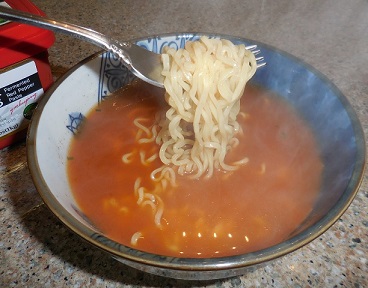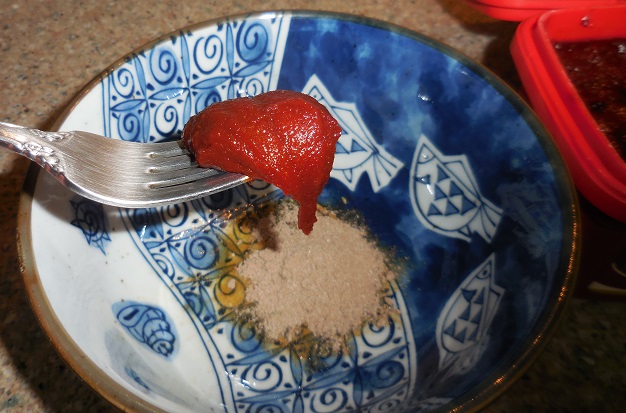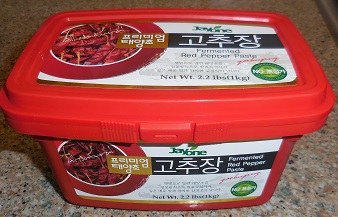
I first encountered ramen when I was stationed in Korea in the early 70’s. Although the ramen I ate there didn’t taste spicy, it always seemed to crank up my inner furnace a bit after I finished a bowl. The packets I buy here in the U.S. are delicious, but they don’t seem to have the magic ingredient that gives you that warm afterglow.
Sometimes, when I’m too busy in the morning to make something more complicated, I take advantage of the convenience and low, low cost of ramen packets to make a quick and easy breakfast. I’ve tried all the flavors and decided I like the beef flavor the best with shrimp/seafood coming in second. The chicken flavoring that comes in the ramen packets has that artificial bullion taste that reminds me of the chicken soup base used in too many dishes by bad restaurants because they don’t want to make the effort to make their own chicken stock. That annoying flavor, along with the bright yellow color would surely ruin a breakfast.
The Discovery
One morning when I was cooking up some ramen I noticed a container of Korean Fermented Red Pepper Paste (also called gochujang) in the fridge. It was given to us by a neighbor who was from Korea. We had admired the taste of something she made for us once and so she presented us with a huge container of the secret ingredient. It sat unused in the back of the refrigerator for longer than I care to admit because we didn’t really know what to do with it and, for some reason, didn’t try to find out.
Anyway, I noticed it in the fridge and on a whim put a dollop of it in my bowl of ramen. It was absolutely delicious.
The easiest way to make it is to start some water boiling, empty the spice packet into a bowl, put a dollop of the red pepper paste in the bowl, and then put the noodles in the boiling water for no more than three minutes. After boiling the noodles, pour them into your bowl and stir it all up so the beef flavoring and red pepper paste are mixed in. The directions call for two cups of water, but I’ve started using a little more because the broth is so flavorful I want more. I probably use about 2.25 – 2.5 cups of water. It’s way too hot for me to eat right away so the noodles get a chance to soak up some flavor from the broth while everything cools down a bit.

An Alternative
One morning I was looking forward to another fine breakfast of noodles in broth when, much to my dismay, I found I had run out of gochujang. After discarding the notion of eating my noodles plain and unadulterated, I began poking around in my larder looking for something to add to them. Here is what I came up with:

That’s it. Miso and Sriracha sauce. The final result didn’t taste the same as my usual gochujang noodles, but it was just as delicious–a little less fermented flavor and a delightful sour taste. I suppose you could use any type of miso and you can vary the amount of hot sauce to suit your preferred level of hot-mouth. I used a dollop of miso (like in the following picture) and a healthy squirt of Sriracha sauce.

A Word On Red Pepper Paste
Korean red pepper paste comes in colorful, reusable plastic tubs with hinged lids that latch when you close them. Sometimes there is little to no English on the label, but if there is any I would look out for the word “hot.” I mistakenly bought a tub once that said “Hot Pepper Paste” and learned that when they sat “hot” they really mean “where’s the fire hose!?!?” In addition to being very spicy, the hot pepper paste had less flavor than the non-hot variety.

Gochujang is available at any Korean food store. I saw it at Costco on my last visit and Amazon sells it, too. Two pounds of this stuff lasts quite a while so I don’t buy it very often, but one thing I’ve noticed in the Korean Supermarket where I usually buy it, is that I rarely see the same brand twice. There are usually at least three different brands available along with a host of other similar plastic tubs of varying colors containing other stuff. I always look for the same brand as what I just ran out of, but never seem to find it. So, I buy another brand it always tastes good.
Gochujang comes in various sizes, but I like the 1 kilo size. Like Goldilocks said, “It’s not too big and it’s not too small–it’s just right.” When our neighbor first gave us some of this it was in a huge (I thought lifetime supply size) tub that looked exactly like the smaller ones except it was way bigger. It’s also possible to buy smaller sizes.

Here’s a good source for some recipes and some more information.
And while we’re on the subject of red, spicy stuff, there’s a great movie about Sriracha Sauce and the man who is responsible for it.
One last thing…
Before sitting down to enjoy a bowl of delicious ramen with fermented red pepper paste, or anything else, remember to thank God for creating so many amazing flavors for us to enjoy.

That really makes me hungry for ramen, et. al.!!!
Oh, this is so good, Greg. You made it all so clear, that I could almost taste it. I’ve never bought Ramen except for Becky’s lunches when she was at Delta. I like your pictures, too. Did you take them with your phone and put them in the WordPress library? I think I’ll start making my pictures larger, too. You can really see them and appreciate the story. Please keep it up. I think I’ll try to pass your blog on to my blogger group. You can also post it on Facebook for other readers!
Reblogged this on SHIRLEY'S HOMEY HOMILIES.
Yum!! I love ramen noodles too and I always put something spicy in it, I haven tried miso though. I will have to try that it sounds great!